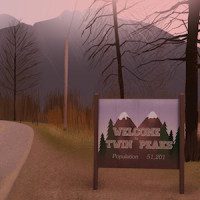This article is part of a series of investigations, reflections, and reminiscences by writers, artists, and musicians who were influenced by David Lynch’s seminal television show Twin Peaks. To read more, or to learn about participation, visit www.twinpeaksproject.com.
***
“People call me a director, but I really think of myself as a sound man.” —David Lynch
Music and film share a strange space, between two worlds. Since the Lumiėre Brothers started screening movies along with a live pianist in 19th-century Paris, film has been defined by its shadow self. Nosferatu is more than creepy when followed by the music of Hans Erdman—he’s a terrifying, otherworldly spook. Many of the finest “talkies” are rooted in musical cues: the creepy single-piano of Krzysztof Komeda’s Rosemary’s Baby, John Carpenter’s skin-crawling ‘70s synths in Halloween, Deliverance’s violent backwoods banjos, or the scorched earth strings of Jonny Greenwood’s There Will Be Blood.
David Lynch has scored his films from the beginning, starting with 1977’s Eraserhead. He told Interview Magazine, “I didn’t know anything about film when I first started—I was a painter— but I [always] felt that sound was just as important as the picture. The sound, picture, and ideas have to marry. If an idea carries with it a mood, sound is critical to making that mood.”
Lynch and composer Angelo Badalamenti began creating Twin Peaks years before filming began. The two initially worked together in 1986 on the menacing, candy-colored Blue Velvet soundtrack, as Badalamenti famously transformed Isabella Rossellini into a disturbed lounge siren. Lynch deemed the project “peachy keen,” and suggested they pen a whole batch of lush, weird-ass ‘80s pop tunes, with him writing the words and Badalamenti making sense of Lynch’s odd and often formless lyrics. With singer Julee Cruise—whose breathy vocals waft around Blue Velvet’s “Mysteries of Love”—the three recorded the Floating Into the Night album, an oddly successful effort that sounds just like 1989. The album includes early version of “Falling”, which is impossible to hear without conjuring the sights and sounds of the instrumental: a wren on a branch, a sharpening saw blade, and the Great Northern Hotel.
Baseball players get a walk-up song that plays over the PA as they head to the plate. With Twin Peaks, Badalamenti and Lynch created a theme song for major characters, creating an immediate aura every time they appear on screen. Badalamenti told Rolling Stone, “The thing about Twin Peaks music is it runs the gamut of styles. It also incorporates pop, blues, some country, soft rock, film noir—no question about that—nightmarish stuff.”
Laura Palmer’s came first, a somber dirge that spreads to enclose the world Lynch created—full of innocence and evil, the supernatural, oddball humor, violence, dreams, and the incessant clash of perception and reality. The two men wrote the piece side-by-side at a piano; Badalamenti explains, “David said, ‘Start it off foreboding, like you’re in a dark wood, and then segue into something beautiful to reflect the trouble of a beautiful teenage girl. Then, once you’ve got that, go back and do something that’s sad and go back into that sad, foreboding darkness,’” the composer recalls. “Maybe it was luck, but literally, in one take, I translated those words into music.”
Audrey Horne: part sweater-girl femme fatale, part naïf. The finger-snapping, lounge lizard jazz of Audrey permeates the entire Twin Peaks world.
Badalamenti’s compositions “The Bookhouse Boys” and “Dance of the Dream Man” are from the same log bag, full of jazz cool and quiet malice. They share added significance because of their heavy associated locales, the Bookhouse and the Black Lodge.
The repertoire of Leland Palmer is absurd—hysterical by default—as the man possessed by Bob does silver-voiced versions of “Mairzy Doats” and “Get Happy.” It’s hilarious and insane, another example of Lynch’s brilliant contrast (not unlike Ben’s “cover” of Roy Orbison’s “In Dreams” in Blue Velvet, pre-joy ride.)
“It is happening, again.” This is it. Agent Cooper and Sherriff Truman share a table with the Log Lady while Julee Cruise does “Rockin’ Back Inside Your Heart” at the Bookhouse. Donna and James share a nearby booth, staring and doing some pretty gross lip-syncing. Then, the music begins to fade, the light begins to rise, and that low alien drone comes in. For me, Twin Peaks can be distilled to that 10-second transition when the Giant appears at the Bookhouse.
After the series, Badalamenti continued to work with Lynch on Mulholland Drive, Wild at Heart, and Lost Highway. Each film is encased, steeped in its own skewed logic and atmosphere. With the recent announcement of the show’s 2016 revival, there’s been speculation as to whether Badalamenti’s original score will also return. In my opinion, it has to—Neil Brand has said that Lynch’s series “couldn’t work without Badalamenti’s music,” but it goes beyond that. Music is where David Lynch’s creative process begins, and without Angelo Badalamenti, Twin Peaks wouldn’t exist.




